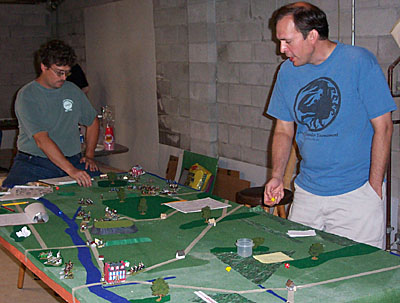 Dan (right) faces the French onslaught of Fred.
Dan (right) faces the French onslaught of Fred.
FORMATIONS:
Column: One stand behind the other, facing same direction.
Line: One stand beside the other, facing same direction
Square (infantry only): One stand behind the other, facing opposite direction
Road March (road movement only): One stand beside the other, facing opposite direction
Three Stands: Two stands forward, one behind (centered) is considered a column.
Four stands:
Two stands forward, two behind is considered a column.
Three stands forward, one behind in center is considered a line.
MORALE CHECK OPTION:
You always roll MCs until you pass!
You can, however, elect to remove a stand instead of rolling a MC. You cannot have less than two stands in a unit. Hey, sometimes, you just want to stand your ground.
RE-INFORCEMENTS:
Some units are "off map" I will let you know when they arrrive.
FRONTS, FLANKS, and REARS:
A front is considered the 180 degrees area created by extending the line of leading edge of the stand out to the sides.
A flank is considered the 90 degrees area created by extending each of the side edges of the stand perpendicular to the front line.
A rear is restricted to the small area not covered by front or flank.
Artillery has flanks and rear.
Squares do not have flanks or rears. They shoot in all directions, with shots = to # of stands. Chargers MUST start the charge with a portion of their unit already in the enemy unit's flank or rear area in order to charge into the flank or rear. Otherwise, charges hit the front.
TURNS AND TIME
The umpire's watch is the only watch that matters. For the first three (3) turns, I will co-ordinate all the tables so everyone has a chance to get used to the system, and how moving from one table to another works, and so on. After that, EACH TABLE keeps their own turn sequence. When moving from one table to another, you adopt the new table's sequence.
If there are NO other players on a table, you can indeed, move through the turn sequence at "warp speed." (representing that the reserves were very cleverly positioned). As you might figure out, establishing troops on every table is a good idea.
TABLES
When moving between tables, call over the umpire. Adjacent tables do not necessarily contain adjacent real estate. Also, the compass orientation is spun.
COMMUNICATIONS BETWEEN PLAYERS
If you are on the same table, talk away. If you are on different tables, you must send written messages via courier (Umpire). Paper and pencils are provided. Write away and call for the umpire courier ("Hey, message boy!" also works). I will date stamp the message and deliver it after a certain amount of time depending on how far the commander is from another.
- PLEASE KEEP YOUR MESSAGES--DO NOT THROW THEM AWAY!
You may NOT send messages to enemy players.
You MUST try to follow your Czar's or Emperor's orders, no matter how odd they seem. They have a bigger picture of the battlefield and often have a reason for you to do something...
If you think of it, jot down some notes and thoughts on the blank paper on your clipboards. It will help me write up the campaign. Thanks.
THE UMPIRE IS ALWAYS RIGHT:
I may make good decisions. I may make bad decisions. But I always try to make consistent decisions. A little player explanation and exhortation is good. A lot is bad and earns you the "Prince Jerome" award. (Prince Jerome, Napoleon's brother, had a snit fit and quit the campaign fairly early on when Napoleon placed him under Davout's command structure).
More Snappy Nappy: The Russian Conflagration of 1812
-
Snappy Nappy Campaign Introduction
SN Rules Experiments: Pushing the Envelope
Preliminaries, Set Up, and Preparation
French Situation and Introduction
Russian Situation and Introduction
Orders of Battle: French and Russian
Snappy Nappy Rules Conventions
The Game From the Umpire's Neutral Perspective
French and Russian Messages in Chronological Order
History: The 1812 Invasion of Russia in a Nutshell
Large Campaign Map (slow: 101K)
Jumbo Campaign Map (monstrously slow: 877K)
Napoleon's Memoirs
Back to War Lore: The List
Back to Master Magazine List
© Copyright 2004 by Coalition Web, Inc.
This article appears in MagWeb.com (Magazine Web) on the Internet World Wide Web.
Other articles from military history and related magazines are available at http://www.magweb.com